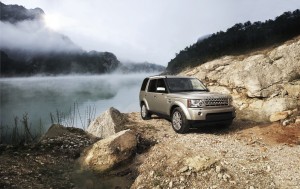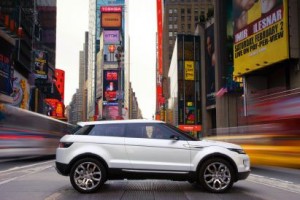
A freshening inside and out for LR4 appears, but still hidden is a more efficient, smaller SUV.
The 2010 LR4 made its first appearance at the New York auto show on April 8. It replaces the LR3, formerly known as the Discovery as the smallest sport utility in the line. The LR4 is essentially an LR3 with a thorough facelift inside and out.
Changes to the Range Rover and Range Rover Sport are less noticeable, including smoother, simpler exterior styling and some additional high-tech features such as an updated version of Land Rover’s adjustable Terrain Response system and a “surround-view” camera display.
All those changes would be okay under normal circumstances, but these are hardly normal circumstances. Land Rover just changed ownership for the third time in 15 years; it’s an all-truck brand in a small-car world; and Land Rover quality is still near the bottom in the J.D. Power Initial Quality Study.
India’s Tata Motors bought Jaguar and Land Rover from Ford Motor Company last June for just $2.3 billion. Ford also kicked in about $600 million for pension plans. That price was markedly less than the $3 billion Ford paid for Land Rover.
 Jaguar was an independent, publicly traded company when Ford bought it in 1990 for $2.38 billion, just as Lexus was gaining momentum and proving Ford’s assumption wrong that you needed heritage to expand a luxury band. Lexus quickly went on to become the best selling luxury brand in the U.S. Jaguar, in spite of billions of dollars of additional investment and grandiose predictions of huge sales gains, languished. Ford then bought Land Rover from Germany’s BMW AG in 2000 hoping that it could cash in on growing truck demand. That assumption too proved dubious. All told, Ford’s investment in both failed brands could total more than $20 billion.
Jaguar was an independent, publicly traded company when Ford bought it in 1990 for $2.38 billion, just as Lexus was gaining momentum and proving Ford’s assumption wrong that you needed heritage to expand a luxury band. Lexus quickly went on to become the best selling luxury brand in the U.S. Jaguar, in spite of billions of dollars of additional investment and grandiose predictions of huge sales gains, languished. Ford then bought Land Rover from Germany’s BMW AG in 2000 hoping that it could cash in on growing truck demand. That assumption too proved dubious. All told, Ford’s investment in both failed brands could total more than $20 billion.

A change in ownership to Tata has slowed development of a smaller, more efficient SUV.
Under the current circumstances, Land Rover desperately needs an all-new, smaller and more fuel-efficient model. That would demonstrate a more obvious break with the brand’s gas-guzzling past, and also get the brand more in tune with cost-conscious customers who may be looking to downsize.
Land Rover has such a model in the pipeline, based on the LRX concept that debuted at Detroit in 2008. (It skipped the 2009 Detroit show in January.) Confirmation is due later this year that it will build a new, smaller vehicle, Land Rover Managing Director Phil Popham said in an interview with TheDetroitBureau.com in New York. That suggests the new model could be a couple of years away, while Land Rover is struggling now. Land Rover’s U.S. sales in the first quarter were down 33% to only 5,847, according to AutoData Corp. In 2008, U.S. sales fell 40% to 29,718. Meanwhile it’s hoping the LR4 will stem the sales slide.
“The LR4 directly addresses customer perceptions, likes and dislikes, and some of the aspects that could have been perceived as low-rent for a luxury brand, such as the use of plastics,” Popham said. “The (LR4) styling really conveys what we call perceived quality, the use of materials, the visual elements. We have really transformed the interior,” he said.
Exterior styling includes a more aerodynamic front end and new headlights. New interior features include revised switches and controls, a new center console, new seats, a new driver information display and new leather and wood options.
The new engines are naturally aspirated and supercharged versions of the 5.0-liter V-8, already launched in the Jaguar XF, with the same basic architecture. The new engines replace a 4.4-liter engine. Land Rover’s version of the V-8 gets modifications like a bigger oil sump, to accommodate the fact that Land Rovers are liable to be tilted at odd angles when they are operating off-road.
The new V-8 also gets direct fuel injection, which improves power without increasing fuel consumption. Between direct injection and bigger displacement, the 375-hp naturally aspirated engine produces 25% more power and 19% more torque than the engine it replaces. Fuel economy numbers, the most critical aspect of the changes, were not released.

how can i get this car